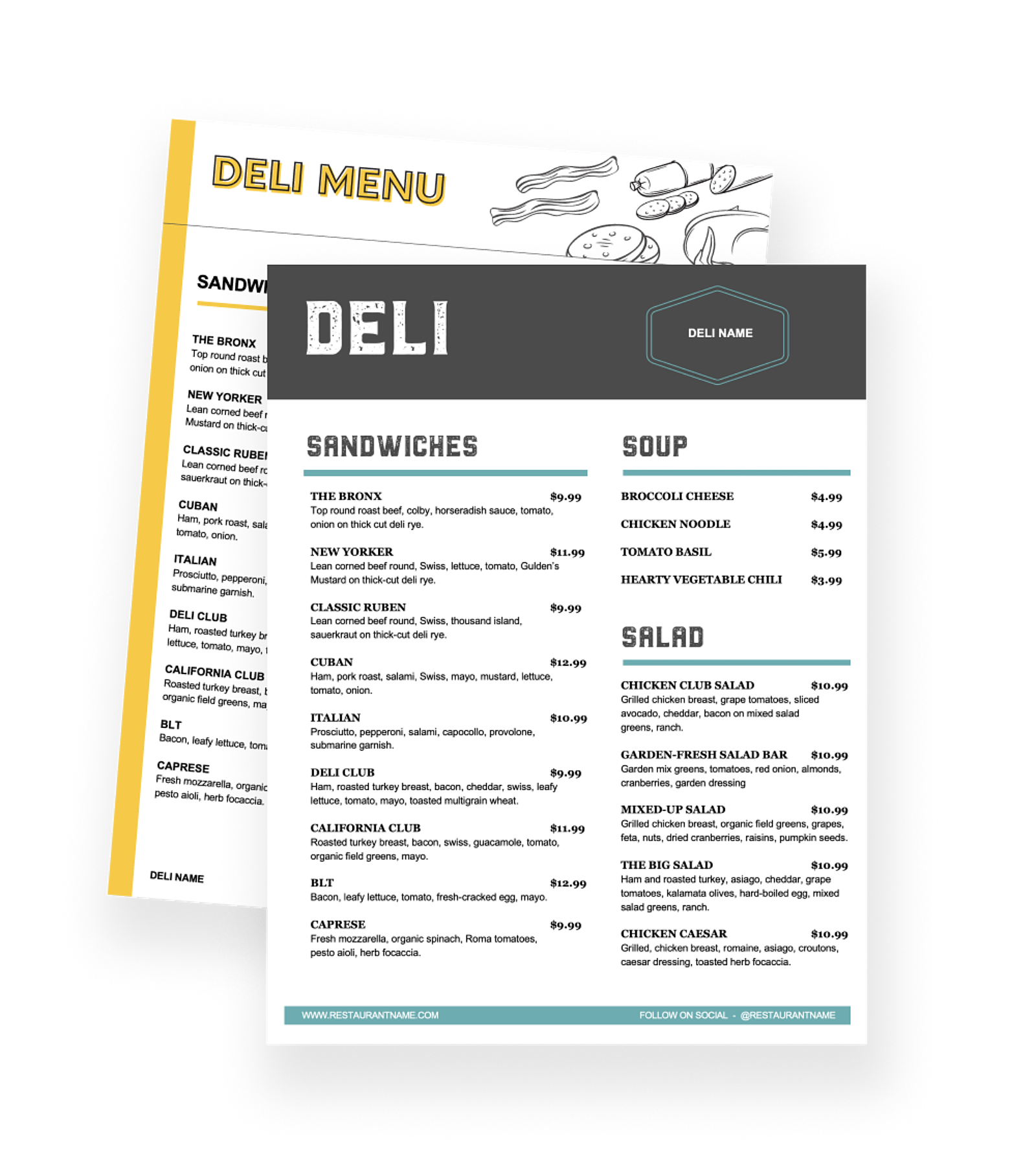
Deli Recipes: How to Develop Deli Recipes [2024]
Here is everything you need to develop your deli recipes, from research and development to testing and scaling.

Caroline PriceAuthor


Deli Menu Templates
Use these deli menu templates as a starting point for your menu design or to give your menu a refresh.
Get free downloadDelicatessens, or delis, have long been a cornerstone of American cuisine, offering a wide array of ready-to-eat foods that cater to diverse tastes and preferences. According to Grand View Research, the global chilled and deli foods market size was estimated at USD 224.92 billion in 2022 and is expected to grow at a compound annual growth rate (CAGR) of 5.7% from 2023 to 2030. The appeal of delicatessen, specialty, and gourmet foods has expanded rapidly as consumers' tastes have become more sophisticated and adventurous.
From classic sandwich recipes to innovative salads and appetizers, deli recipes have become an integral part of our culinary landscape. This guide will help aspiring deli owners and food enthusiasts develop standout recipes tailored specifically for a deli setting, ensuring creativity and consistency in their offerings.
Menu Engineering Course
Take this course to make the most of your menu. Learn about menu psychology and design, managing your menu online, and adapting your menu to increase sales.

Steps to Developing Your Deli Recipes
1. Research and Inspiration
Creating exceptional deli recipes begins with thorough research and abundant inspiration.
Explore Food Trends and Popular Cuisines
Stay updated on current food trends and popular cuisines by subscribing to food industry reports and publications. Explore how these trends can be adapted to deli classics. For example, consider incorporating plant-based alternatives into traditional deli sandwiches or creating gluten-free versions of favorite recipes to cater to health-conscious customers.
Visit Local Delis and Food Markets
Spend time at local delis to understand what makes them successful. Observe the best-selling items, customer preferences, and unique twists on traditional recipes. Take note of the presentation, portion sizes, and ingredient combinations. Additionally, visit food markets to discover fresh, local ingredients that can inspire new dishes and seasonal specials.
Follow Deli-Focused Food Blogs and Social Media Influencers
Follow food blogs and social media influencers who specialize in deli cuisine. Platforms like Instagram and Pinterest can provide visual inspiration and highlight emerging trends in deli food. Look for innovative takes on classic dishes, such as gourmet chicken salad variations or creative uses for pastrami and roast beef.
Attend Food Festivals and Culinary Events
Food festivals and culinary events showcase innovative takes on classic dishes and provide networking opportunities with chefs and food enthusiasts. Attend these events to gather new ideas and insights into potential menu items for your deli. For example, a New York-style food festival might inspire new sandwich recipes or appetizer ideas.
2. Defining Your Deli Concept
A clear and distinct concept is essential for developing a cohesive menu.
Identify Your Target Market and Their Preferences
Determine the demographics of your target market. Are they office workers looking for quick lunches, families seeking convenient dinner options, or food enthusiasts craving gourmet deli experiences? Understanding your customers will help you tailor your menu to their tastes and preferences.
Choose a Specific Cuisine or Fusion of Cuisines
Decide whether your deli will focus on traditional American fare, Italian deli classics, or a fusion of cuisines. For instance, you might blend New York-style deli offerings with Mediterranean influences, creating a unique menu that includes dishes like pastrami-topped Greek salads alongside classic Reubens.
Determine Your Unique Selling Proposition (USP)
Identify what sets your deli apart. This could be a signature sandwich recipe, house-made salad dressings, or a particular ingredient sourcing method. Your USP should resonate with your target market and reflect in your recipes. For example, a deli might be known for its artisanal bread or locally sourced, organic ingredients.
When asked about what sets The Bagel in Chicago, Illinois apart from other delis, owner Danny Wolf shared with Chicago magazine, “Longevity is one thing. We’re dealing with second-, third-, and fourth-generation customers and they’ve got a proprietary interest. They feel like owners of the business. It’s part of their lives, their background, and their history. Some people used to come in with their grandparents and now they bring their own children. And then when I say I remember their grandmother and I tell them what she ate, you can see our bond.”
Consider Dietary Needs and Preferences
Modern delis often cater to various dietary needs. Include vegetarian, vegan, gluten-free, and low-carb options on your menu to accommodate a broader customer base. Offering a variety of options ensures that all customers feel welcome and can find something they enjoy.
If you’re looking for ideas to meet your customers’ various dietary needs, take inspiration from Rebel Cheese. This all-vegan deli offers artisan charcuterie-style vegan (dairy-free) cheeses.
3. Brainstorming and Initial Recipe Ideas
With your concept in mind, start brainstorming and generating initial recipe ideas.
List Potential Dishes That Fit Your Concept
Create a list of dishes that align with your deli's theme. Think about classic deli staples like sandwiches, salads, soups, and sides, and consider how you can put a unique twist on them. For instance, a deli focusing on Italian-American fusion might offer a Caprese sandwich with crispy prosciutto or a pasta salad with a pesto dressing.
Consider Seasonal Ingredients and Local Produce
Incorporate seasonal ingredients and local produce to ensure freshness and support local farmers. This approach can also inspire seasonal specials that keep your menu exciting. For example, a summer menu might feature fresh tomatoes and basil in salads and sandwiches, while a fall menu could highlight roasted sweet potatoes and crisp apples.
Chewish Deli, located in Alexandria, VA, offers seasonal schmears. One of their popular summer menu items is dill pickle cream cheese.
Think About Menu Diversity
A well-rounded deli menu should include a variety of options, including hot and cold sandwiches, salads, side dishes, appetizers, and desserts. This diversity caters to different tastes and keeps your offerings appealing. Ensure that you have options for different meal times and occasions, such as quick grab-and-go lunches and more substantial dinner options.
4. Recipe Development Process
Developing recipes involves a detailed and iterative process.
Start with Basic Versions of Each Dish
Begin with simple, basic versions of your dishes. Focus on nailing the fundamental flavors and techniques before experimenting with more complex variations. For example, start with a classic chicken salad recipe before adding unique ingredients like diced apples or toasted almonds.
Experiment with Different Ingredients and Cooking Techniques
Test different ingredients and cooking techniques to enhance your dishes. For example, try various types of cheese for your sandwiches, or different marinades for your roast beef. Experiment with cooking methods like slow-roasting, smoking, or grilling to find the best approach for each ingredient.
Focus on Balancing Flavors, Textures, and Presentation
Strive for a balance of flavors (sweet, salty, sour, bitter, umami), textures (crispy, creamy, crunchy), and presentation (portion, garnish, freshness). A visually appealing dish with a well-rounded taste profile will leave a lasting impression. For instance, a turkey sandwich with crispy bacon, creamy avocado, and tangy cranberry sauce offers a satisfying mix of textures and flavors.
Keep Portion Sizes and Pricing in Mind
Ensure your portion sizes are generous yet manageable, and pricing is competitive. Delis are known for offering good value, so finding this balance is crucial. Analyze your costs and set prices that ensure profitability while providing value to customers.
5. Testing and Refining Recipes
Testing and refining your recipes ensures they meet high standards.
Conduct Taste Tests with Friends, Family, and Potential Customers
Invite friends, family, and potential customers to taste your dishes. Their feedback can provide valuable insights into what works and what needs improvement. Create a feedback form to gather specific comments on flavor, texture, presentation, and overall satisfaction.
Gather Feedback on Flavor, Presentation, and Overall Appeal
Collect detailed feedback on the flavor, presentation, and overall appeal of each dish. This information is essential for making necessary adjustments. Pay attention to recurring comments and be willing to make changes based on the feedback received.
Make Adjustments Based on Feedback and Retest
Use the feedback to refine your recipes and retest them. This iterative process helps in achieving the perfect balance of taste and quality. For example, if testers find a sandwich too salty, adjust the seasoning and retest until it reaches the desired flavor profile.
Ensure Consistency in Taste and Quality
Consistency is key to building a loyal customer base. Ensure that every serving of your dish meets the same high standards. Develop standardized recipes and train your staff to follow them precisely, ensuring that each dish is prepared and presented consistently.
6. Sourcing Ingredients
High-quality ingredients are the backbone of great deli recipes.
Find Reliable Suppliers for Fresh and High-Quality Ingredients
Establish relationships with reliable suppliers who can provide fresh and high-quality ingredients consistently. Look for suppliers who share your commitment to quality and can deliver on time. This is particularly important for key ingredients like meats, cheeses, and produce.
Build Relationships with Local Farmers and Markets
Supporting local farmers and markets not only ensures fresh produce but also fosters community connections and sustainability. Attend farmers' markets and build relationships with local producers to source the best ingredients for your deli. This can be especially beneficial for seasonal ingredients and specialty items.
Tír Deli, located in Dublin, Ireland, is a seasonal deli whose core values are “deliciousness, irishness, and sustainability.” All of their fruits, vegetables, meats, coffee, and bread are sourced from local farmers.
Consider Cost-Effective Options Without Compromising Quality
While quality is paramount, it's important to find cost-effective options. Bulk purchasing and negotiating with suppliers can help manage costs. Consider working with multiple suppliers to find the best prices without compromising on quality. For example, you might source your deli meats from one supplier and your cheeses from another to ensure the best quality-to-price ratio.
Plan for Ingredient Availability and Seasonality
Plan your menu around the availability and seasonality of ingredients to maintain quality and keep costs manageable. Create a seasonal menu that highlights the freshest ingredients available, ensuring your dishes are always at their best. This might include offering a tomato and mozzarella sandwich only during peak tomato season or featuring a butternut squash soup in the fall.
7. Scaling Recipes for a Deli
Scaling recipes for a deli setting requires careful planning.
Adjust Recipe Quantities for Larger Batches
Modify your recipes to accommodate larger batch sizes, ensuring that the taste and quality remain consistent. Use precise measurements and scaling techniques to maintain the integrity of each dish. This is particularly important for items like salad dressings, marinades, and sauces.
Ensure Consistency in Taste and Presentation for Every Serving
Develop a standardized process for preparing and serving each dish to maintain consistency in taste and presentation. Create detailed recipe cards and training materials for your kitchen staff to follow. This might include specific instructions on how to assemble sandwiches or portion salads.
Whether on their website or Instagram, Call Your Mother’s bagels are consistently presented cut in half, revealing their delicious insides.
Develop a System for Efficient Prep and Cooking in the Deli
Create an efficient prep and cooking system that allows for quick service without compromising quality. This might include pre-prepping ingredients, organizing your kitchen layout for optimal workflow, and streamlining cooking processes to handle peak times effectively. For example, you might pre-slice meats and cheeses during slow periods to prepare for lunch rushes.
Consider Storage and Space Limitations in the Deli
Be mindful of storage and space limitations. Optimize your kitchen layout and storage solutions to ensure smooth operations. Invest in space-saving equipment and organize your pantry and fridge to maximize efficiency. This might include using vertical storage solutions or investing in high-quality food storage containers to keep ingredients fresh and easily accessible.Elevate Your Deli Recipes
Developing deli recipes is an art that combines creativity, culinary skill, and business acumen. By following this comprehensive guide, you can create a menu of delicious, innovative deli recipes that will delight your customers and set your establishment apart. Remember that the key to success lies in continuous improvement and adaptation to customer preferences and market trends. With dedication and attention to detail, your deli recipes can become the cornerstone of a thriving business, offering memorable flavors and experiences to your patrons.
Related Resources
Is this article helpful?
DISCLAIMER: This information is provided for general informational purposes only, and publication does not constitute an endorsement. Toast does not warrant the accuracy or completeness of any information, text, graphics, links, or other items contained within this content. Toast does not guarantee you will achieve any specific results if you follow any advice herein. It may be advisable for you to consult with a professional such as a lawyer, accountant, or business advisor for advice specific to your situation.
Read More
Subscribe to On the Line
Sign up to get industry intel, advice, tools, and honest takes from real people tackling their restaurants’ greatest challenges.



